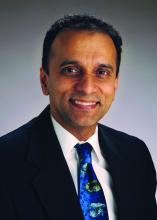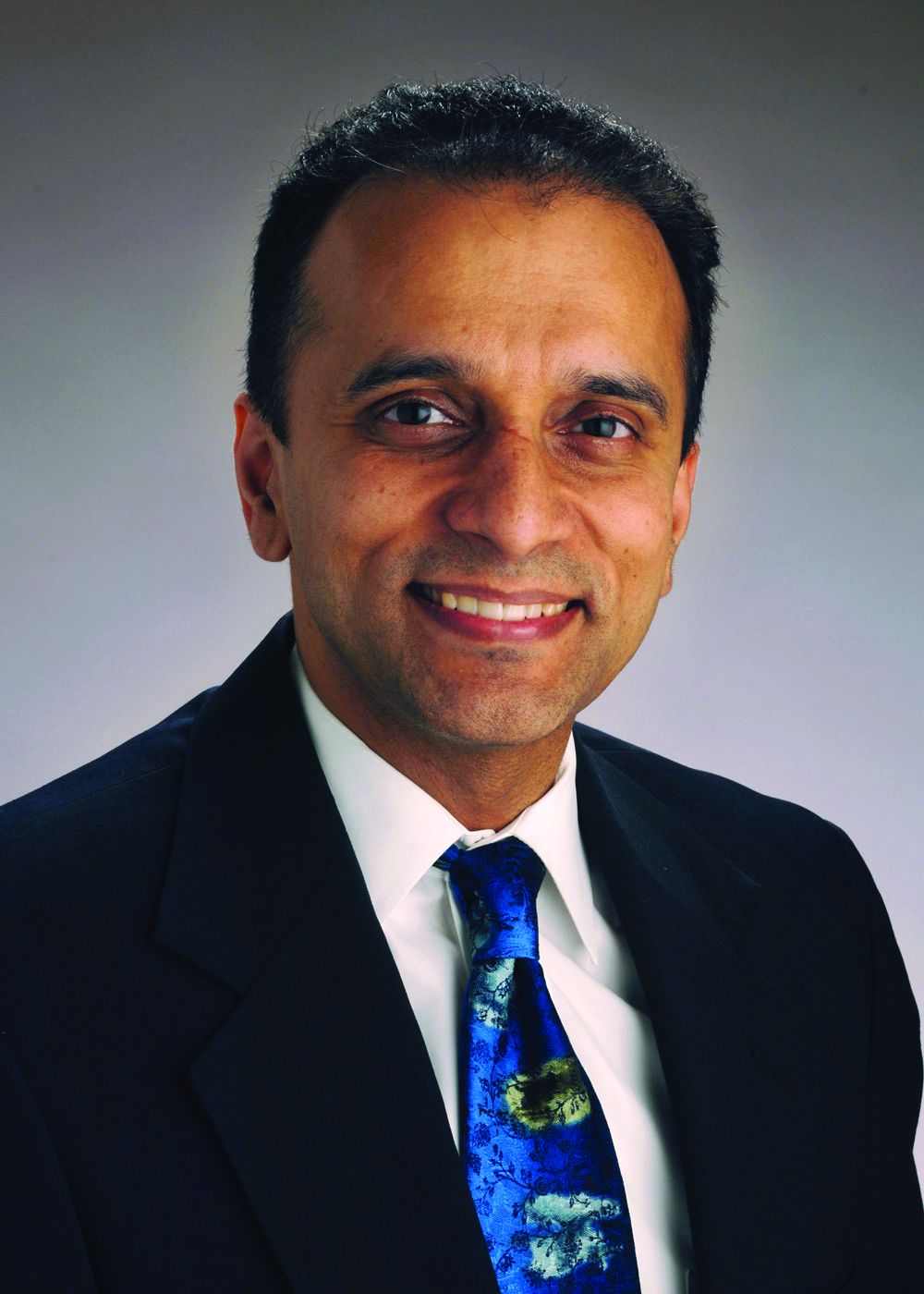User login
LAS VEGAS – While endoscopic therapy of Barrett’s esophagus is often successful, the risk of recurrence after complete ablation remains considerable, according to Prateek Sharma, MD, of the department of medicine in the division of gastroenterology and hepatology at the University of Kansas, Kansas City.
“This is not perfect therapy,” Dr. Sharma said in a presentation at the inaugural Perspectives in Digestive Diseases meeting held by Global Academy for Medical Education.
The risk of recurrence for intestinal metaplasia was 7.1% per patient-year, authors of that study found. The risk of dysplastic Barrett’s esophagus was 1.3% per patient-year in the meta-analysis, while the risk of high-grade dysplasia or esophageal adenocarcinoma was 0.8%.
Because of these risks, patients should be followed up regularly with careful examination and biopsies to ensure there is no recurrent intestinal metaplasia, dysplasia, or adenocarcinoma, Dr. Sharma told attendees at the meeting.
“If it comes back, you can still treat it endoscopically,” he continued, “but you have to be aware of the situation, and inform the patient that it can be curative, but at the same time it’s not a 100% success story in all situations.”
When patients do develop early cancers or high-grade lesions, the latest evidence suggests endoscopic therapy is effective and helps avoid esophagectomy in the majority of patients.
“It used to be esophagectomy for all,” Dr. Sharma said. “Now the paradigm has switched, and it is endoscopic therapy for all.”
That paradigm shift is supported in part by a German study showing excellent long-term results in 1,000 consecutive patients receiving endoscopic treatment of mucosal adenocarcinoma of the esophagus.
In that study, nearly all of the patients (963, or 96.3%) had a complete response, with 12 patients undergoing surgery because of failure of endoscopic therapy. Fifteen patients (1.5%) had major complications that were nonetheless managed conservatively, according to investigators. Although new lesions or recurrences were seen in 140 patients (14.5%) over 5 years of follow-up, 115 patients had successful endoscopic retreatment. Based on these data, the investigators calculated a 10-year survival rate of 75%.
On the basis of these findings, investigators said endoscopic therapy should be considered the standard of care for patients with mucosal adenocarcinoma of the esophagus.
“That’s the paradigm shift that I was talking about – now, we are sending less than 4% of our patients for surgery for this condition,” Dr. Sharma said at the meeting.
Global Academy and this news organization are owned by the same parent company.
Dr. Sharma reported disclosures related to Medtronics, National Institutes of Health, and US Endoscopy.
LAS VEGAS – While endoscopic therapy of Barrett’s esophagus is often successful, the risk of recurrence after complete ablation remains considerable, according to Prateek Sharma, MD, of the department of medicine in the division of gastroenterology and hepatology at the University of Kansas, Kansas City.
“This is not perfect therapy,” Dr. Sharma said in a presentation at the inaugural Perspectives in Digestive Diseases meeting held by Global Academy for Medical Education.
The risk of recurrence for intestinal metaplasia was 7.1% per patient-year, authors of that study found. The risk of dysplastic Barrett’s esophagus was 1.3% per patient-year in the meta-analysis, while the risk of high-grade dysplasia or esophageal adenocarcinoma was 0.8%.
Because of these risks, patients should be followed up regularly with careful examination and biopsies to ensure there is no recurrent intestinal metaplasia, dysplasia, or adenocarcinoma, Dr. Sharma told attendees at the meeting.
“If it comes back, you can still treat it endoscopically,” he continued, “but you have to be aware of the situation, and inform the patient that it can be curative, but at the same time it’s not a 100% success story in all situations.”
When patients do develop early cancers or high-grade lesions, the latest evidence suggests endoscopic therapy is effective and helps avoid esophagectomy in the majority of patients.
“It used to be esophagectomy for all,” Dr. Sharma said. “Now the paradigm has switched, and it is endoscopic therapy for all.”
That paradigm shift is supported in part by a German study showing excellent long-term results in 1,000 consecutive patients receiving endoscopic treatment of mucosal adenocarcinoma of the esophagus.
In that study, nearly all of the patients (963, or 96.3%) had a complete response, with 12 patients undergoing surgery because of failure of endoscopic therapy. Fifteen patients (1.5%) had major complications that were nonetheless managed conservatively, according to investigators. Although new lesions or recurrences were seen in 140 patients (14.5%) over 5 years of follow-up, 115 patients had successful endoscopic retreatment. Based on these data, the investigators calculated a 10-year survival rate of 75%.
On the basis of these findings, investigators said endoscopic therapy should be considered the standard of care for patients with mucosal adenocarcinoma of the esophagus.
“That’s the paradigm shift that I was talking about – now, we are sending less than 4% of our patients for surgery for this condition,” Dr. Sharma said at the meeting.
Global Academy and this news organization are owned by the same parent company.
Dr. Sharma reported disclosures related to Medtronics, National Institutes of Health, and US Endoscopy.
LAS VEGAS – While endoscopic therapy of Barrett’s esophagus is often successful, the risk of recurrence after complete ablation remains considerable, according to Prateek Sharma, MD, of the department of medicine in the division of gastroenterology and hepatology at the University of Kansas, Kansas City.
“This is not perfect therapy,” Dr. Sharma said in a presentation at the inaugural Perspectives in Digestive Diseases meeting held by Global Academy for Medical Education.
The risk of recurrence for intestinal metaplasia was 7.1% per patient-year, authors of that study found. The risk of dysplastic Barrett’s esophagus was 1.3% per patient-year in the meta-analysis, while the risk of high-grade dysplasia or esophageal adenocarcinoma was 0.8%.
Because of these risks, patients should be followed up regularly with careful examination and biopsies to ensure there is no recurrent intestinal metaplasia, dysplasia, or adenocarcinoma, Dr. Sharma told attendees at the meeting.
“If it comes back, you can still treat it endoscopically,” he continued, “but you have to be aware of the situation, and inform the patient that it can be curative, but at the same time it’s not a 100% success story in all situations.”
When patients do develop early cancers or high-grade lesions, the latest evidence suggests endoscopic therapy is effective and helps avoid esophagectomy in the majority of patients.
“It used to be esophagectomy for all,” Dr. Sharma said. “Now the paradigm has switched, and it is endoscopic therapy for all.”
That paradigm shift is supported in part by a German study showing excellent long-term results in 1,000 consecutive patients receiving endoscopic treatment of mucosal adenocarcinoma of the esophagus.
In that study, nearly all of the patients (963, or 96.3%) had a complete response, with 12 patients undergoing surgery because of failure of endoscopic therapy. Fifteen patients (1.5%) had major complications that were nonetheless managed conservatively, according to investigators. Although new lesions or recurrences were seen in 140 patients (14.5%) over 5 years of follow-up, 115 patients had successful endoscopic retreatment. Based on these data, the investigators calculated a 10-year survival rate of 75%.
On the basis of these findings, investigators said endoscopic therapy should be considered the standard of care for patients with mucosal adenocarcinoma of the esophagus.
“That’s the paradigm shift that I was talking about – now, we are sending less than 4% of our patients for surgery for this condition,” Dr. Sharma said at the meeting.
Global Academy and this news organization are owned by the same parent company.
Dr. Sharma reported disclosures related to Medtronics, National Institutes of Health, and US Endoscopy.
EXPERT ANALYSIS FROM PERSPECTIVES IN DIGESTIVE DISEASES

